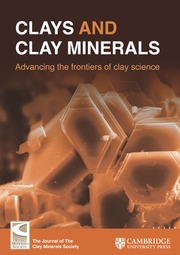Crossref Citations
This article has been cited by the following publications. This list is generated based on data provided by
Crossref.
Ling, Hui
Lu, Anhuai
Wang, Changqiu
Li, Yan
Chen, Peng
Zhou, Jiangong
and
Wang, Jian
2011.
Treatment of Municipal Landfill Leachate with Organically Modified Bentonite.
Clays and Clay Minerals,
Vol. 59,
Issue. 5,
p.
518.
Fil, Baybars Ali
Ozmetin, Cengiz
and
Korkmaz, Mustafa
2012.
Cationic Dye (Methylene Blue) Removal from Aqueous Solution by Montmorillonite.
Bulletin of the Korean Chemical Society,
Vol. 33,
Issue. 10,
p.
3184.
Mahmoodi, Niyaz Mohammad
Sadeghi, Unes
Maleki, Afshin
Hayati, Bagher
and
Najafi, Farhood
2014.
Synthesis of cationic polymeric adsorbent and dye removal isotherm, kinetic and thermodynamic.
Journal of Industrial and Engineering Chemistry,
Vol. 20,
Issue. 5,
p.
2745.
Baran, Evrim
and
Acemioğlu, Bilal
2016.
Competitive Removal of Malachite Green and Rhodamine B Using Clinoptilolite in a Two-dye System.
Clays and Clay Minerals,
Vol. 64,
Issue. 3,
p.
299.
Hadjltaief, Haithem Bel
Zina, Mourad Ben
Da Costa, Patrick
and
Gálvez, María Elena
2016.
Heterogeneous TiO2–Fe-plate catalyst for the discoloration and mineralization of aqueous solutions of cationic and anionic dyes.
Desalination and Water Treatment,
Vol. 57,
Issue. 29,
p.
13505.
Raval, Nirav P.
Shah, Prapti U.
and
Shah, Nisha K.
2016.
Adsorptive amputation of hazardous azo dye Congo red from wastewater: a critical review.
Environmental Science and Pollution Research,
Vol. 23,
Issue. 15,
p.
14810.
Raval, Nirav P.
Shah, Prapti U.
and
Shah, Nisha K.
2017.
Malachite green “a cationic dye” and its removal from aqueous solution by adsorption.
Applied Water Science,
Vol. 7,
Issue. 7,
p.
3407.
Popoola, Lekan Taofeek
Aderibigbe, Tajudeen Adejare
Yusuff, Adeyinka Sikiru
and
Munir, Musleema Mofehintoluwa
2018.
Brilliant green dye adsorption onto composite snail shell–rice husk: Adsorption isotherm, kinetic, mechanistic, and thermodynamics analysis.
Environmental Quality Management,
Vol. 28,
Issue. 2,
p.
63.
Patel, Bhargav R.
Maeno, Kenichi
Ganesh, Hashwin V. S.
Endo, Tatsuro
and
Kerman, Kagan
2019.
TiO2-coated 2D photonic crystals for reflectometric determination of malachite green.
Microchimica Acta,
Vol. 186,
Issue. 12,
Xu, Minhong
Qian, Mengxia
Pan, Guoxiang
Guo, Yuhua
and
Wu, Tao
2019.
Photocatalytic Activity of La-Containing Mixed- Metal Oxides Derived from Layered Double Hydroxides to Degrade Methylene Blue in the Presence of H2O2.
Clays and Clay Minerals,
Vol. 67,
Issue. 4,
p.
253.
Karabayir, Erhan
Ozdemir, Abdil
Senkal, B. Filiz
and
Taskin, Omer S.
2019.
A radioactively durable melamine-styrene based polymer: Highly efficient removal of 90Sr.
Applied Radiation and Isotopes,
Vol. 149,
Issue. ,
p.
96.
Fideles, Renata Aparecida
Teodoro, Filipe Simões
Xavier, Amália Luísa Pedrosa
Adarme, Oscar Fernando Herrera
Gil, Laurent Frédéric
and
Gurgel, Leandro Vinícius Alves
2019.
Trimellitated sugarcane bagasse: A versatile adsorbent for removal of cationic dyes from aqueous solution. Part II: Batch and continuous adsorption in a bicomponent system.
Journal of Colloid and Interface Science,
Vol. 552,
Issue. ,
p.
752.
Popoola, Lekan Taofeek
Yusuff, Adeyinka Sikiru
Adesina, Olusola Adedayo
and
Lala, Mayowa Adeoye
2019.
Brilliant Green Dye Sorption onto Snail Shell-rice Husk: Statistical and Error Function Models as Parametric Isotherm Predictors.
Journal of Environmental Science and Technology,
Vol. 12,
Issue. 2,
p.
65.
Bessaha, F.
Mahrez, N.
Marouf-Khelifa, K.
Çoruh, A.
and
Khelifa, A.
2019.
Removal of Congo red by thermally and chemically modified halloysite: equilibrium, FTIR spectroscopy, and mechanism studies.
International Journal of Environmental Science and Technology,
Vol. 16,
Issue. 8,
p.
4253.
Adebayo, Matthew A.
Adebomi, Joshua I.
Abe, Taiwo O.
and
Areo, Felicia I.
2020.
Removal of aqueous Congo red and malachite green using ackee apple seed–bentonite composite.
Colloid and Interface Science Communications,
Vol. 38,
Issue. ,
p.
100311.
Khalilzadeh Shirazi, Elham
Metzger, Jörg W.
Fischer, Klaus
and
Hassani, Amir Hessam
2020.
Removal of textile dyes from single and binary component systems by Persian bentonite and a mixed adsorbent of bentonite/charred dolomite.
Colloids and Surfaces A: Physicochemical and Engineering Aspects,
Vol. 598,
Issue. ,
p.
124807.
Shi, Yan
Wang, Xisen
Wang, Xin
Carlson, Kristen
and
Li, Zhaohui
2021.
Removal of Toluidine Blue and Safranin O from Single and Binary Solutions Using Zeolite.
Crystals,
Vol. 11,
Issue. 10,
p.
1181.
El Messaoudi, Noureddine
El Khomri, Mohammed
Chegini, Zahra Goodarzvand
Bouich, Amal
Dbik, Abdellah
Bentahar, Safae
Labjar, Najoua
Iqbal, Munawar
Jada, Amane
and
Lacherai, Abdellah
2022.
Dye removal from aqueous solution using nanocomposite synthesized from oxalic acid-modified agricultural solid waste and ZnFe2O4 nanoparticles.
Nanotechnology for Environmental Engineering,
Vol. 7,
Issue. 3,
p.
797.
El Khomri, Mohammed
El Messaoudi, Noureddine
Dbik, Abdellah
Bentahar, Safae
Lacherai, Abdellah
Chegini, Zahra Goodarzvand
and
Bouich, Amal
2022.
Removal of Congo red from aqueous solution in single and binary mixture systems using Argan nutshell wood.
Pigment & Resin Technology,
Vol. 51,
Issue. 5,
p.
477.
Tang, Ruihao
Hong, Wei
Srinivasakannan, C.
Liu, Xuelin
Wang, Xin
and
Duan, Xinhui
2022.
A novel mesoporous Fe-silica aerogel composite with phenomenal adsorption capacity for malachite green.
Separation and Purification Technology,
Vol. 281,
Issue. ,
p.
119950.

